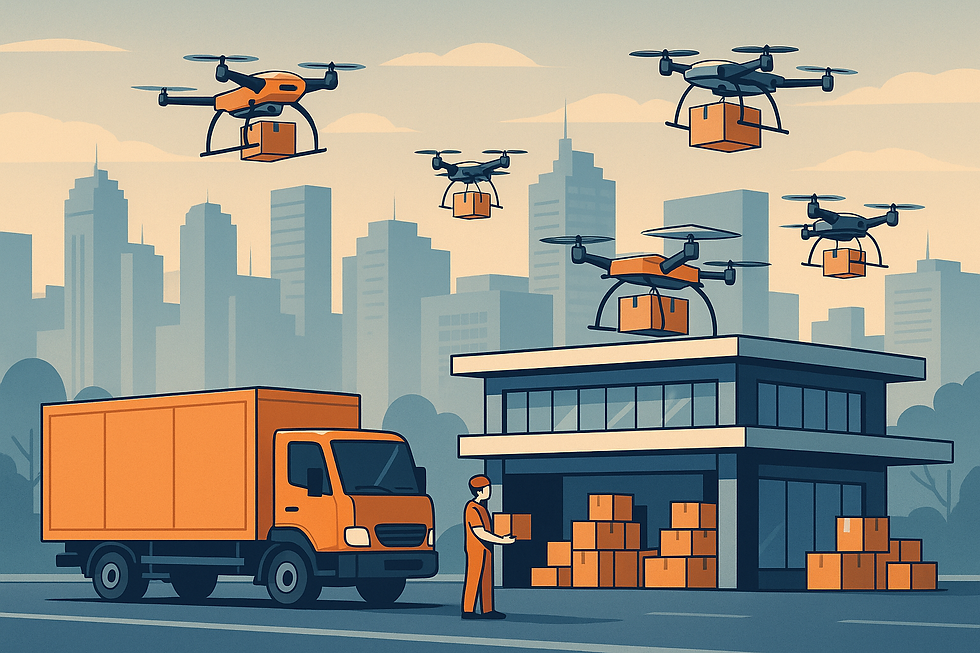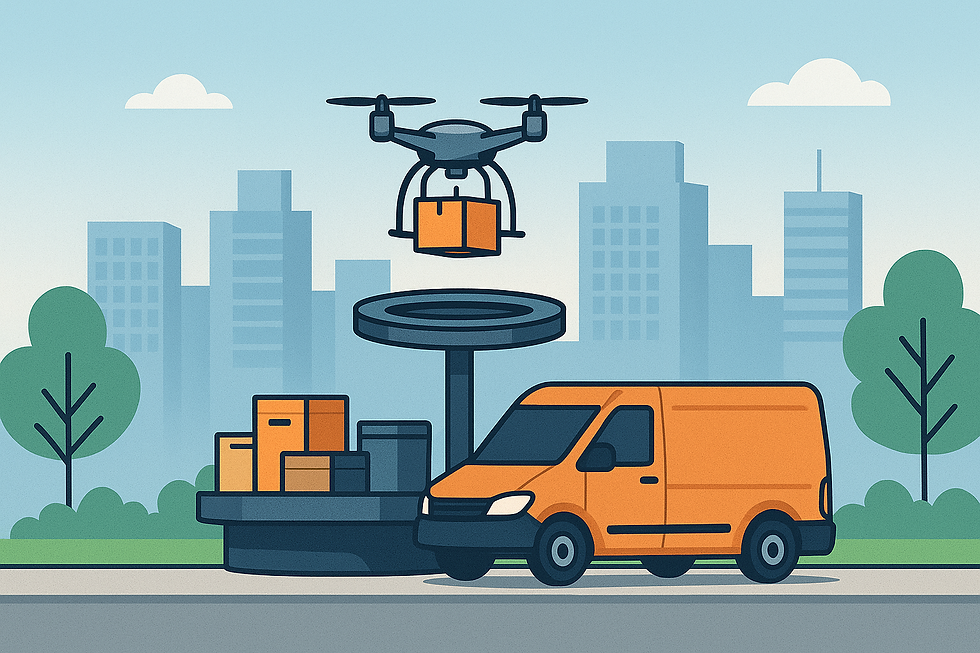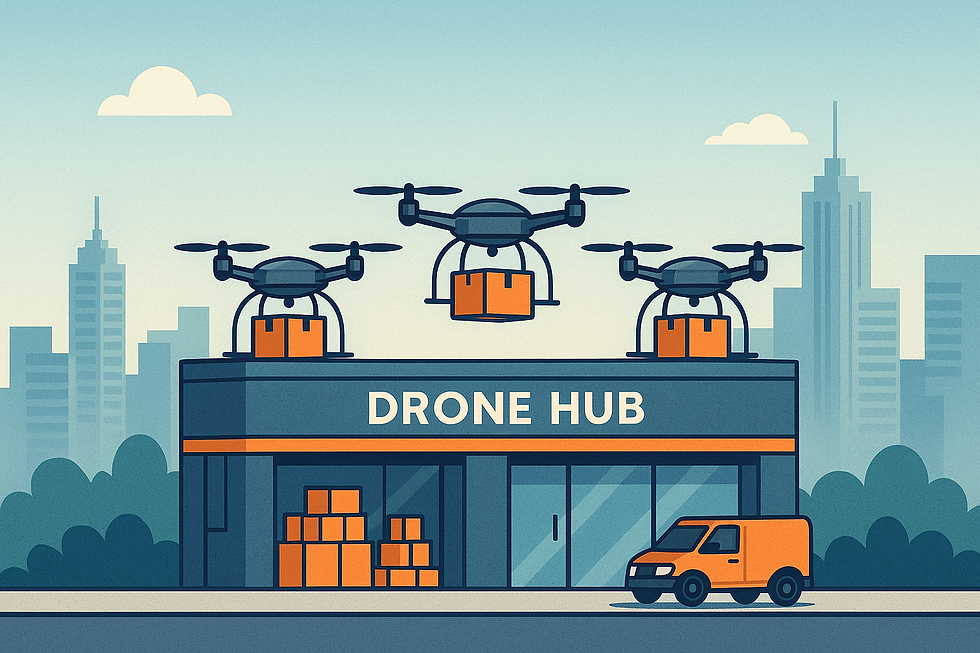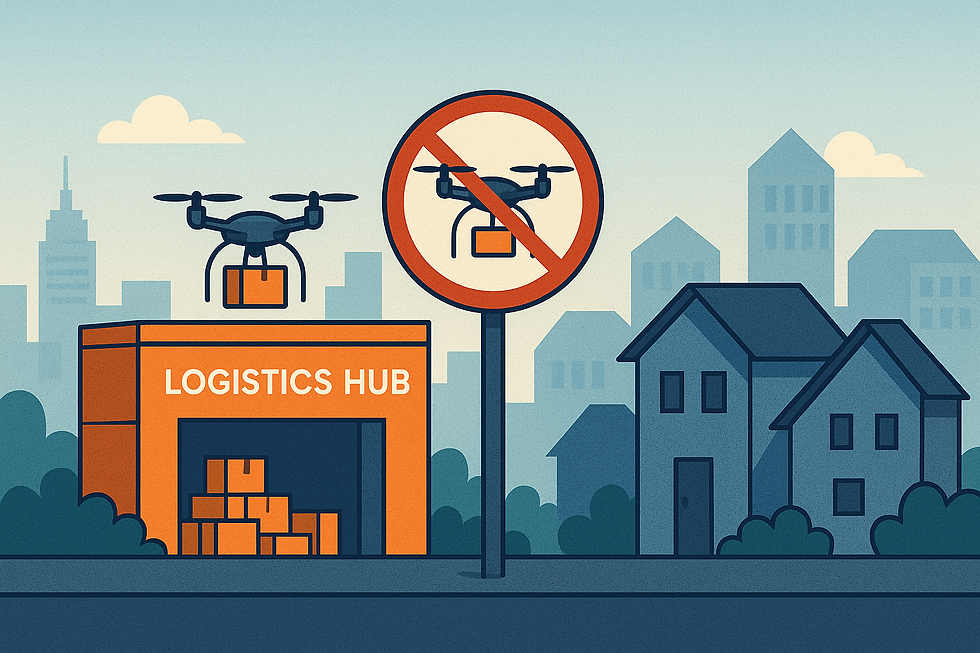How Drone Hubs Could Reshape the Last-Mile Delivery Network in Cities
- Gebler Tooth Architects

- Jul 15
- 4 min read

As urban populations swell and e-commerce continues to dominate consumer behaviour, the pressure on last-mile logistics has never been greater. Roads are congested, delivery windows are shrinking, and sustainability is a growing concern. In this landscape, the integration of drone hubs into urban logistics networks isn’t just a futuristic vision—it’s becoming a practical necessity.
But what does this really look like? How can drone infrastructure be meaningfully integrated into existing logistics systems? And what impact will this have on cities, businesses, and citizens?
Let’s explore how drone hubs could reshape the last mile in our urban future.
The Last Mile Is Broken
The "last mile" of delivery—getting goods from distribution centres to their final destination—is widely recognised as the most expensive, time-consuming, and emissions-heavy stage in the supply chain. According to McKinsey, last-mile delivery can account for over 50% of total shipping costs. In dense urban areas, traffic delays, parking issues, and complex delivery routes all contribute to inefficiency.
On top of this, consumers now expect same-day or even same-hour delivery, making it even harder for logistics providers to keep up using conventional vehicles and infrastructure.
This is where drones come in.
Drones: A Tool for Urban Efficiency

Drones offer a compelling set of advantages:
Speed: By flying directly to delivery points, drones can bypass congested roads entirely.
Access: In cities with hard-to-reach buildings, rooftop drop-offs or balcony deliveries could become the norm.
Sustainability: Electric drones produce zero tailpipe emissions, supporting cities' low-carbon transport goals.
Scalability: Fleets can be deployed dynamically in response to demand, offering flexible capacity.
But for all this promise, the true challenge lies not in the drones themselves—but in how they’re integrated into the city.
Introducing the Urban Drone Hub

To deliver at scale, drones need infrastructure: places to launch, land, recharge, store goods, and integrate with existing logistics systems. This is where the concept of the urban drone hub comes into play.
An urban drone hub is essentially a micro-distribution centre, vertically connected to the airspace. It may be co-located with existing facilities like warehouses, supermarkets, or parcel lockers—or built into rooftops, car parks, or even transit stations.
Think of it as a plug-in module within the logistics network, linking ground-based freight with aerial routes to complete the last mile.
Use Cases Already Emerging
Several companies and city authorities are already piloting this concept:
Skyports (UK) has worked with architects and planners to design modular drone logistics hubs for both passenger and cargo use. Their "Vertiport" concept includes drone delivery zones connected to local couriers and e-commerce platforms.
Zipline, originally focused on rural medical supply delivery, is now launching urban hubs in the US for fast home delivery of groceries and prescriptions.
Wing (owned by Alphabet) is building out a drone delivery network in suburban and urban locations, leveraging small drone "nests" on top of retail locations.
These early examples show that drone hubs don’t need to be massive structures—they can be small, networked, and embedded into existing buildings or underused spaces.
Challenges to Integration

While the vision is compelling, several challenges remain when embedding drone hubs into urban logistics:
1. Zoning and Regulation
Most cities weren’t designed with aerial logistics in mind. Zoning laws, airspace permissions, and building use regulations all need to adapt. There’s also the matter of integrating drone airspace corridors into existing flight zones.
2. Noise and Community Acceptance
Even small electric drones make noise. If they’re launching from hubs near residential areas, cities will need to ensure designs are quiet and shielded—and that community engagement is proactive and ongoing.
3. Space and Real Estate
Urban space is limited. Converting rooftops or building new structures takes time, capital, and planning permission. Logistics companies may need to partner with building owners or councils to unlock the right locations.
4. Network Integration
Drone hubs need to be digitally integrated with existing logistics software, inventory systems, and driver routes. They’re not a replacement for trucks or vans—but a complementary layer in a multi-modal system.
The Opportunity for Cities
For city authorities and urban planners, drone hubs present an opportunity to rethink logistics infrastructure as a public service.
By reducing delivery van traffic, drone hubs can ease road congestion and free up curbside space. In cities struggling with air quality and emissions, drones offer a low-impact alternative to fossil-fuelled vehicles.
Planners can also incorporate drone logistics into transport-oriented development, embedding delivery points into mobility hubs and metro stations—much like lockers or bike storage.
Some cities are even exploring the idea of shared logistics infrastructure, where hubs are open to multiple operators, not just a single company. This helps reduce duplication and promotes fairness in how airspace is used.
What Good Looks Like
So what does successful integration of drone hubs into urban logistics look like?
Design-led infrastructure: Compact, modular, and scalable hubs that blend into their surroundings—ideally co-located with existing transport or retail buildings.
Smart zoning policies: Clear rules for where and how drone hubs can operate, with input from communities, businesses, and planners.
Public-private partnerships: Logistics companies working with councils and property developers to share space and data.
Sustainability and inclusivity: Ensuring that drone delivery doesn’t just serve premium services—but improves logistics for all, including underserved areas.
Looking Ahead
The integration of drone hubs into urban logistics is not just a technological shift—it’s an urban design challenge. It requires thinking differently about space, speed, and service.
In the next decade, we won’t just see drones in the sky. We’ll see buildings that launch them, streets that accommodate them, and supply chains that depend on them.
Done right, drone hubs could become a core layer of the urban delivery ecosystem—faster, cleaner, and better suited to the demands of 21st-century cities.
Author’s Note:If you're an architect, planner, or logistics professional interested in the future of urban delivery, start thinking vertically. The sky is no longer the limit—it’s the new last mile.



Comments